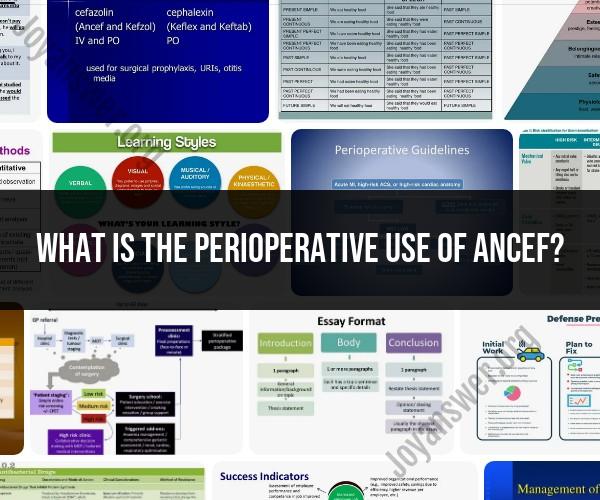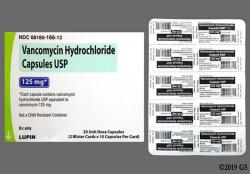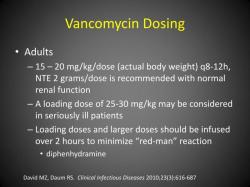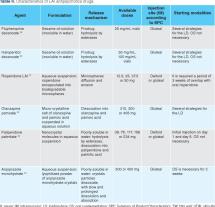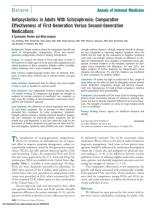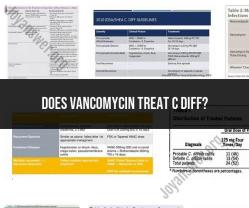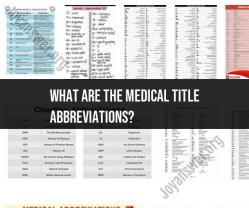What is the perioperative use of Ancef?
Ancef is a brand name for the antibiotic drug cefazolin, which belongs to the cephalosporin class of antibiotics. The perioperative use of Ancef refers to its administration before and during surgical procedures as a form of antibiotic prophylaxis. Antibiotic prophylaxis involves the use of antibiotics to prevent surgical site infections (SSIs) that can occur after surgery. Here's how the perioperative use of Ancef works:
1. Timing of Administration:
- Ancef is typically administered shortly before surgery, usually within 30 minutes to 1 hour before the surgical incision is made. This timing ensures that the antibiotic is present in the body at adequate levels when the surgical site is exposed.
2. Purpose:
- The primary purpose of giving Ancef or a similar antibiotic before surgery is to reduce the risk of infection at the surgical site. Infections that occur after surgery can lead to complications, prolonged hospital stays, and additional medical treatments.
3. Selection of Patients:
- Antibiotic prophylaxis is not necessary for all surgical procedures. It is typically reserved for certain types of surgeries with a higher risk of SSIs, such as orthopedic, abdominal, cardiac, or vascular surgeries. The decision to use Ancef as prophylaxis is based on the type of surgery, the patient's medical history, and established clinical guidelines.
4. Duration of Administration:
- Ancef is usually given as a single dose shortly before surgery. In some cases, additional doses may be administered during lengthy procedures or if the surgery involves a high risk of infection.
5. Mechanism of Action:
- Cefazolin, the active ingredient in Ancef, works by inhibiting the growth of bacteria at the surgical site. It targets a broad spectrum of bacteria, including those commonly associated with SSIs.
6. Efficacy:
- The use of Ancef and similar antibiotics as prophylaxis has been shown to be effective in reducing the incidence of SSIs. However, the choice of antibiotic may depend on the specific pathogens that are common in a particular surgical setting.
7. Risk of Antibiotic Resistance:
- Prophylactic antibiotic use is carefully managed to minimize the development of antibiotic resistance. Antibiotics like Ancef are selected based on their efficacy against the most likely pathogens and are used only for a short duration.
8. Adverse Effects:
- Like all medications, Ancef can have side effects. Common side effects may include allergic reactions, gastrointestinal disturbances, and the potential for antibiotic-associated diarrhea. Patients are carefully screened for allergies and other contraindications before administration.
9. Consultation with Healthcare Providers:
- The decision to use Ancef as perioperative antibiotic prophylaxis should be made by the surgical team in consultation with infectious disease specialists and pharmacists. The choice of antibiotic, timing, and dosage should adhere to established clinical guidelines.
It's important to note that the perioperative use of antibiotics like Ancef is a preventative measure and should not be used as a treatment for existing infections. Additionally, the use of antibiotics should be in accordance with local healthcare guidelines and protocols to ensure patient safety and minimize the risk of antibiotic resistance.
Perioperative Use of Ancef: Benefits and Considerations
Ancef (cefazolin) is a cephalosporin antibiotic that is commonly used in the perioperative setting. It is effective against a wide range of bacteria, including those that commonly cause surgical site infections (SSIs). Ancef is also relatively safe and well-tolerated, making it a good choice for patients of all ages.
Benefits of using Ancef in the perioperative setting:
- Reduces the risk of SSIs
- Broad-spectrum activity against bacteria that commonly cause SSIs
- Relatively safe and well-tolerated
- Can be used in patients of all ages
Considerations for using Ancef in the perioperative setting:
- Cost: Ancef is more expensive than some other antibiotics, such as penicillin.
- Allergic reactions: Cephalosporins can cause allergic reactions, especially in patients who are allergic to penicillins.
- Antibiotic resistance: Overuse of antibiotics can lead to antibiotic resistance, which can make it more difficult to treat infections in the future.
Antibiotic Prophylaxis with Ancef in Surgical Settings
Antibiotic prophylaxis is the use of antibiotics to prevent infection. It is commonly used in the perioperative setting to reduce the risk of SSIs. Ancef is a good choice for antibiotic prophylaxis because it is effective against a wide range of bacteria and is relatively safe and well-tolerated.
Guidelines for antibiotic prophylaxis with Ancef in surgical settings:
- Ancef should be administered intravenously 30-60 minutes before surgery.
- The dose of Ancef depends on the type of surgery and the patient's risk of infection.
- Ancef may be continued for 24-72 hours after surgery, depending on the type of surgery and the patient's risk of infection.
Ancef in Surgery: Optimizing Perioperative Antibiotic Use
It is important to optimize the use of antibiotics in the perioperative setting to reduce the risk of SSIs and antibiotic resistance. Here are some tips for optimizing the use of Ancef in surgery:
- Use the correct dose of Ancef for the type of surgery and the patient's risk of infection.
- Do not continue Ancef for longer than necessary.
- Use other preventive measures to reduce the risk of SSIs, such as good surgical technique and wound care.
If you have any questions about the use of Ancef in the perioperative setting, please talk to your doctor or pharmacist.
